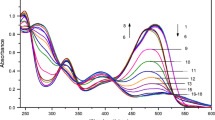Abstract
As selenium is an important part of the antioxidant enzymes and also because there are several studies suggesting a possible link between cancer and selenium deficiency, this paper presents a spectrophotometric method for the assay of Se(IV), using N,N-diethyl-p-phenylenediamine monohydrochloride as reagent. The proposed method is based on the reaction between the selenium and potassium iodide in low acidic medium, when iodine is released. This last product will further oxidise the new reagent. The final obtained product is strongly coloured in red and has an absorption maximum at 552 nm and molar extinction coefficient (ε) of 6.1 × 104 L mol−1 cm−1. The optimum working conditions were established, and the developed method was validated, being characterised by a good linearity (in the range of 0.5–3.0 μg/mL), a limit of detection (0.0573 μg/mL) and a limit of quantification (0.1737 μg/mL). At the same time, the repeatability, the precision of the method and the accuracy were established. The proposed and validated method was applied with good results for the determination of Se(IV) in spring and bottled water from Iasi and also in pharmaceutical and cosmetic products.



Similar content being viewed by others
References
Beck, M. A., Levander, O., & Handy, J. (2003). Selenium deficiency and viral infection. Journal of Nutrition, 133, 1463S–1467S.
Combs, G. F., Clark, L. C., & Turnbull, B. W. (2001). An analysis of cancer prevention by selenium. BioFactors, 14, 153–159.
Food and Nutrition Board, Institute of Medicine. (2000). Dietary reference intakes for vitamin C, vitamin E, selenium and carcinoids (pp. 284–324). New York: National Academic.
Goldhaber, S. B. (2003). Trace element risk assessment: essentiality vs. toxicity. Regulatory Toxicology and Pharmacology, 38, 232–242.
Hathcock, J. (1997). Vitamins and minerals: efficacy and safety. American Journal of Clinical Nutrition, 66, 427–437.
Knekt, P., Marniemi, J., Teppo, L., Heliovaara, M., & Aromaa, A. (1998). Is low selenium status a risk factor for lung cancer? American Journal of Epidemiology, 148, 975–982.
Kose, K., Dogan, P., Kardas, Y., & Saraymen, R. (1996). Plasma selenium levels in rheumatoid arthritis. Biological Trace Element Research, 53, 51–56.
Levander, O. A., & Beck, M. A. (1997). Interacting nutritional and infectious etiologies of Keshan disease. Insights from coxsackie virus B-induced myocarditis in mice deficient in selenium or vitamin E. Biological Trace Element Research, 56, 5–21.
Lippman, S. M., Klein, E. A., Goodman, P. J., Lucia, M. S., Thompson, I. M., Ford, L. G., et al. (2009). Effect of selenium and vitamin E on risk of prostate cancer and other cancers: the Selenium and Vitamin E Cancer Prevention Trial (SELECT). Journal of American Medical Association, 301, 39–51.
Neve, J. (1996). Selenium as risk factors for cardiovascular disease. Journal of Cardiovascular Risk, 3, 42–47.
Niedzielski, P., & Siepak, M. (2003). Analytical methods for determining arsenic, antimony and selenium in environmental samples. Polish Journal of Environmental Studies, 12(6), 653–667.
Revanasiddappa, H. D., & Kiran Kumar, T. N. (2001). A facile spectrophotometric method for the determination of selenium. Analytical Science, 17, 1309–1312.
Sasakura, C., & Suzuki, K. T. (1998). Biological interaction between transition metals (Ag, Cd and Hg), selenide/sulfide and selenoprotein P. Journal of Inorganic Biochemistry, 71, 159–162.
Singhal, N., & Austin, J. (2002). A clinical review of micronutrients in HIV infection. International Association of Physicians in AIDS Care, 1, 63–75.
Terry, N., Zayed, A. M., DeSouza, M. P., & Tarun, A. N. (2000). Selenium in higher plants. Annual Review of Plant Physiology and Plant Molecular Biology, 51, 401–432.
Whange, P. D. (2002). Selenocompounds in plants and animals and their biological significance. Journal of the American College of Nutrition, 21(3), 223–232.
Author information
Authors and Affiliations
Corresponding author
Rights and permissions
About this article
Cite this article
Tantaru, G., Vieriu, M. & Popescu, MC. Validation of spectrophotometric method for Se(IV) determination: analytical applications. Environ Monit Assess 186, 3277–3282 (2014). https://doi.org/10.1007/s10661-014-3618-8
Received:
Accepted:
Published:
Issue Date:
DOI: https://doi.org/10.1007/s10661-014-3618-8




